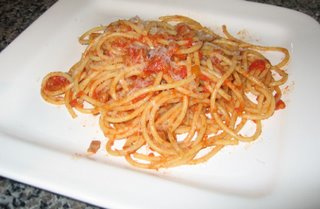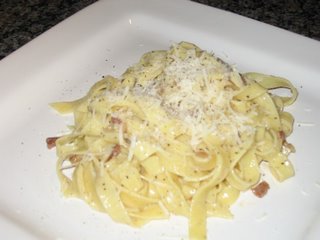Just like with the sausages, it was difficult to let a day go by without going down to the basement to check on the progress of my experiment. Within a couple of days, the surface of the meat was dry and began to darken in color.
I should point out that the meat was hanging just 10 feet or so away from the washer and dryer. So every time that my lovely wife was downstairs to do a load of laundry, she was forced to come face to face with the jowls. Some of you may be wondering what her thoughts were about this whole meat curing madness - I think it best that she speak for herself.
"That thing better not smell!"
"How long does it have to be there?"
"I'm not eating any of that, you know."
"That's disgusting - I can't stand to look at it."
Yup, that about sums it up.
The 6 weeks came and went pretty quickly (partially aided by a two week trip to China). It was time to cut it down and eat. I washed off the salt which had dried and hardened into a rigid shell, trimmed the end, and carved myself a thin slice. It tasted a lot like prosciutto, but less salty. This was a good sign. Since guanciale is almost always cooked before serving, I sliced off another piece and sauteed it up. The flavor was surprisingly like bacon despite the complete lack of smoke used in the preparation process. However, the flavor was richer and, well, meatier. And it was awesome!
Honestly, as a first foray, I would have been quite happy if the stuff had been simply edible. Instead, I got something that surpassed my wildest expectations. If I had known how good this was going to be, those 6 weeks would have been a lot longer! I wrapped my prize in a freezer bag and placed it delicately in the fridge. I went to sleep a happy man that night. Two days later, having experienced no health issues, I was confident that the guanciale was safe to eat.
With a viable product to use, I could now get down to the businiss of cooking with my guanciale. I decided to first try an old favorite, Pasta alla Carbonara. I had always made this dish with pancetta (which there's nothing wrong with), but I was told that guanciale makes an especially mean carbonara. I have included my own recipe at the end of this post. Let's just say that you should make this - even if you can't get your hands on some guanciale. Pancetta will make a great dish too, just different.
So I made carbonara for dinner, with a skeptical wife squinting her eyes at me with a look that said, "You're not going to make me eat that, are you?" When I was done, I prepared a plate and brought it out to my bride. Now that there was hot, ridiculously good looking food that smelled great out on the table, Hollis began to rethink her vehement protesting. She enjoyed every bite.
With this rousing success under my belt, I turned my attention to the most famous of guanciale dishes - Bucatini all'Amatriciana. Since I had never had this dish, I used the method that Josh Friedland described in his article. Once again, the dish was fantastic. The tomatoes and hot spice are a nice compliment to the richness and flavor of the guanciale in this dish. I would definitely make this again.
Pork-face pasta aka Bucatini all'Amatriciana
I still have about 2/3 of the guanciale sitting safely in the fridge, so if anyone is interested in taking some, let me know. And if you happen to be in the Fitchburg area, come on by and experience the fatty goodness for yourself. Maybe this is the only fitting end to this story. It's one thing to read about food, but real understanding can only come in the tasting of it.
Part 1 - In Pursuit of Guanciale
Part 2 - Getting Cheeky
Rich's Carbonara
Serves 2 as a main dish
1/4 lb guanciale, sliced and roughly chopped
1/2 c dry white wine
2 eggs
1/4 c grated pecorino romano cheese
1/2 c grated Parmigiano Reggiano
Lots of freshly ground black pepper
1/2 lb pasta - I prefer tagliatelli or fettucini
2Tbsp olive oil
Salt
Put a large pot of water on to boil. Meanwhile, get together all the other ingredients.
Once the pasta water has come to a boil, add the olive oil and guanciale to a large, heavy skillet over medium heat. The guanciale should brown and render out all the fat, crisping up in the process. While the guanciale is browning up, add 3-4Tbsp of salt to the pasta water and then add in the pasta. This starts your timeclock - remember, the pasta never waits for the sauce! Tagliatelli should cook for about 8-10 minutes, so keep this in mind.
In a medium sized bowl, beat the eggs and add the two cheeses and a good 2 Tbsp of coarsely ground black pepper (about 20 twists or so - you are using fresh ground pepper, aren't you?) and mix together. Reserve.
Once the guanciale is browned and crispy, deglaze the pan with the white wine. Scrape all the brown bits from the bottom of the pan. This is tasty stuff. Let the wine reduce until it is 25% of its original volume, about 4-5 minutes. At this point, the pasta should be cooked al dente and is ready to come out. Take the pan with the guanciale and reduced wine off of the heat and add the pasta. Add the egg mixture, stirring continuously so that every strand of pasta is coated, but the eggs do not scramble (the residual heat from the pasta and the pan will "cook" the eggs, making a rich sauce). Top with extra Parmigiano Reggiano and black pepper before serving.






2 comments:
Your blog is awesome! I am definitely going to try the recipe (I have had it at your house, and loved it). Save me some of your various cured products for when we visit!
Okay, a comment from one of your Cahg-lee-oh-nee friends... now you know I admire you and respect you... but I gotta say this! Carbonara is for spaghetti ONLY! Now, I know it'll taste well with fettuccine but a true roman would never dare... I am a purist! Great job on the blog!!!
Post a Comment